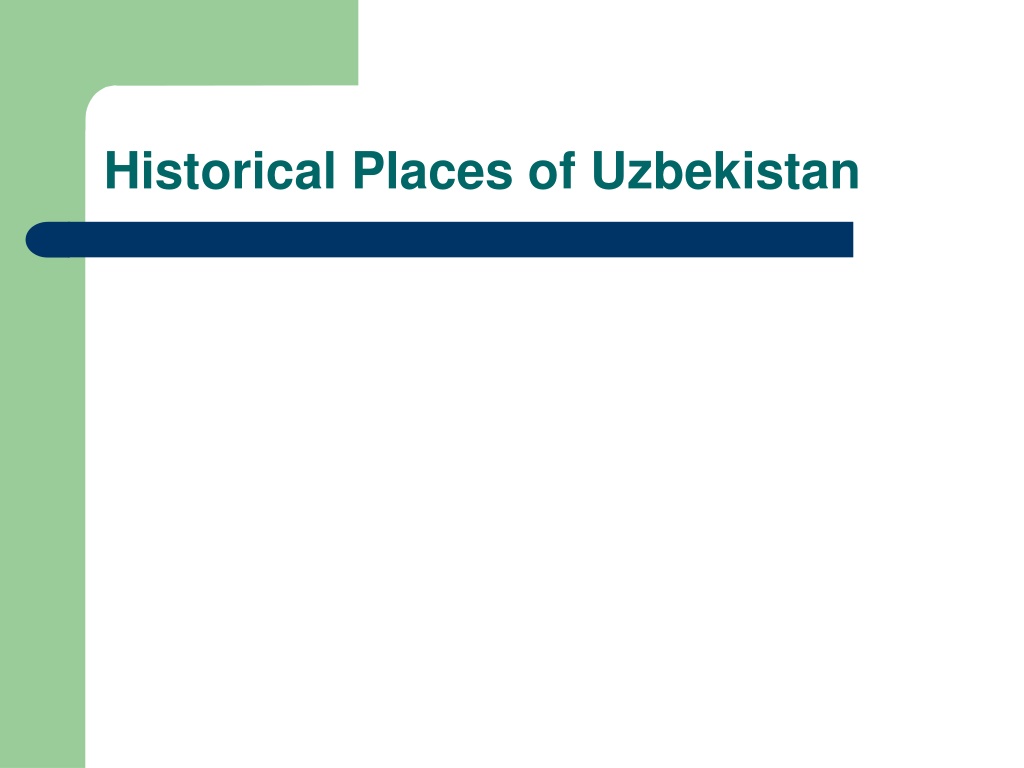
Discovering Historical Gems of Uzbekistan
Explore the rich history and architectural marvels of Uzbekistan through visits to historical places in Tashkent, Samarkand, Bukhara, and Khiva. From the impressive Ulugbek Observatory to the stunning Shakhi-Zinda Necropolis, each site holds centuries of stories and cultural significance waiting to be uncovered.
Download Presentation

Please find below an Image/Link to download the presentation.
The content on the website is provided AS IS for your information and personal use only. It may not be sold, licensed, or shared on other websites without obtaining consent from the author. If you encounter any issues during the download, it is possible that the publisher has removed the file from their server.
You are allowed to download the files provided on this website for personal or commercial use, subject to the condition that they are used lawfully. All files are the property of their respective owners.
The content on the website is provided AS IS for your information and personal use only. It may not be sold, licensed, or shared on other websites without obtaining consent from the author.
E N D
Presentation Transcript
PLAN: HISTORICAL PLACES OF TASHKENT HISTORICAL PLACES OF SAMARKAND HISTORICAL PLACES OF BUKHARA HISTORICAL PLACES OF KHIVA www.arxiv.uz
Khavendi Takhur Sheikh Mausoleum It was founded at the 14th 15th centuries and its above-ground part was constructed between the 18th and 19th centuries. The preserved building was constructed on the old foundation keeping the basic architectural forms. Ziaratkhona and gur-khona are accommodated in the mausoleum. Light-yellow color bricks were used for construction of the mausoleum. No any decoration was used here. www.arxiv.uz
Ulugbek Observatory In the 20ties of 15th century on one of the hills, the governor of Samarkand, Mirzo Ulugbek, built the biggest observatory in the East that can not compare with any other in the world. His star tables Zidji-Gurgani plied by him in his observatory in Samarkand, have kept their scientific value to date: astronomic tables content coordinates of 1018 stars. By Babur's words, who have seen the observatory, it was the three-storied building covered with beautiful glazed titles. The observatory 30-meters height building had 46 meters in diameter. A huge instrument sextant was placed in the observatory to observe the Moon, the Sun and other starts of the vault of heaven. Shortly, after the death of Ulugbek the observatory was destroyed and its location forgotten. In the early years of the 20th century the observatory was rediscovered and excavated by the archaeologist V.Vyatkin. The bottom part of its main device was found a huge quadrant with a radius of 40.2 meters and an arc 63 meters long. Presently, the Ulugbek Museum is situated next to the remains of the former observatory. Pages of the Zij as well as medieval engravings, photographs of the archaeological dig and a collection of astronomical instruments are displayed at the museum. www.arxiv.uz
Shakhi-Zinda Necropolis On south-eastern slope of Afrasiab is situated one of the famous architectural ensembles of Samarkand Shakhi-Zinda Necropolis. This picturesque memorial ensemble (Shakhi-Zinda means "The Alive Tsar"), named after burial complex where the first cousin of the Prophet Kusam Ibn Abbas was buried, could be rightfully called "The Necklace of Architectural Masterpieces". Shakhi-Zinda is the most ancient architectural monument of Samarkand (midst of the 11th c.). The ensemble consisting of eleven mausoleums, built on one after another during the 14th 15th centuries, was known as a big religious and cultural centre. Beginning from the 14th century, the Shakhi-Zinda Ensemble is considered a holy place of Samarkand. The Amir Burunduk Mausoleum, the portals of two anonymous mausoleums and the octahedral mausoleum were added in the 1380s to'90s. Mausoleums under the rulers of Amir Temur, Mirzo Ulugbek and other Temurids are the brilliant page in the history of architecture of Samarkand. The ensemble created during centuries, is remarkable for the unprecedented magnificence of its architectural decor. The refined beauty of Shakhi-Zinda seems to defy death and proclaim the eternity of the true, spiritual life. www.arxiv.uz
The Registan Square It is located in the centre of the ancient city of Samarkand and includes many architectural monuments that make up this unique complex. Ulugbek, "The Scientist on the Throne", patron of science and education and grandson of Amir Temur, erected buildings such as medressahs, khanakas and mosques on the central part of the square. The beautiful and majestic buildings of Ulugbek (15th c.), Sher-Dor (17th c.) and Tillya-Kari (17th c.) are still part of Registan Square today. In the time of Amir Temur the Registan became the main meeting place and focus for trade and crafts activities. It became a centre on which the six main streets of the city radically converged. Under Ulugbek the Registan was used for military parades and public decrees. After completing construction of medressah Ulugbek gave lectures on mathematics and astronomy till his death. Two years later after construction of the Ulugbek Medressah, the ruler of Samarkand Yalangtush Bahadur ordered to build the copy of the medressah and the second, Sher-Dor Medressah was built opposite it. Several years later, the same ruler of Samarkand ordered the third Tillya-Kari Medressah that was built like medressah but used mostly as mosque: Tillya-Kari has low minarets to call people to pray. www.arxiv.uz
Ark Citadel High citadel Ark, strengthened with walls, was the centre of the city, showing the military power of the ruler. The palace, treasury and prison were located just here too. Buildings preserved today in the Ark, were constructed at the end of the 18th beginning of the 20th centuries. Today the Ark Citadel is a big earthen platform stretched from west to east. A lot of buildings are located inside the Ark Citadel. Presently, the eastern part of the Ark represents the archaeological monument. Childukhtaron Mosque is still preserved here accommodating now the historical museum. www.arxiv.uz
Chor-Minor Medressah The four-towered entrance preserved to date is especially majestic giving the complex its name Chor-Minor (Four Minarets). It was constructed at the beginning of the 19th century by order of the rich merchant, Turkmen Khalif Niyazkul, a traveler and carpet and horse seller. It stands by itself and as a beautiful pearl, shining in the sunlight under a perfect blue sky. It is truly unique, a philosophical monument that has no match in the architecture of Central Asia. www.arxiv.uz
Minaret Islam-Khoja The medressah is not so great with a traditional architecture but the main facade is covered with a rich decoration. The majestic 45-metre Minaret Islam-Khoja can be seen from everywhere. It is narrow at the top, with a lantern-shaped top crowned with a small cupola. www.arxiv.uz
Minaret Kalta-Minor Close to the Muhammad Amin-khan Medressah it was started construction of minaret, which according to the khan's idea should be the highest one in Khiva. But because of the khan's death the construction of the minaret was not completed. That is the reason for its title Kalta Minor ("Short Minaret"). Its massive trunck coming thinner on top, is decorated with glazed bricks. www.arxiv.uz
Dictionary Compare - Heaven - founded - consisting - constructed - unprecedented - converged - represents - sunlight - lantern-shaped - www.arxiv.uz
USED LITERATURES http://www.uzbekembassy.org/ THANK YOU! www.arxiv.uz






















